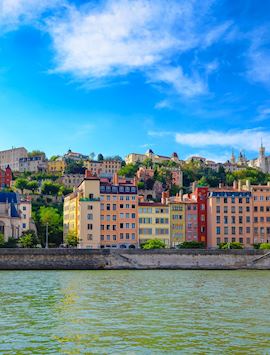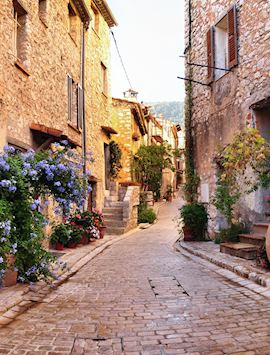Jump to:
The warm, golden-stone streets of Arles were made famous by Vincent van Gogh who painted 200 or so works here. He was smitten by the town's understated allure, the life along the river banks and the bucolic surrounding countryside.
The town is set on the banks of the Rhône between Montpellier and Marseilles, and its laid-back pace, Roman ruins, modern art galleries and cafés make it a rewarding place to explore.
Originally a Celtic settlement, Arles became an important Roman trade hub and eventually the capital of Gaul, Britain and Spain. Reminders of this illustrious heritage are all over the town from the underground galleries of the Cryptoportiques which were once part of the Roman forum, to the partly preserved Constantin Baths which date back to the 4th century. However, by far the most impressive monument to the sheer might and engineering skills of the Romans is their arena which stands largely intact in the heart of the town.
 This monumental oval structure dates from about 90 AD and had a capacity for about 21,000 spectators who came to see chariot races and battles between slaves, gladiators and wild animals. The arena comes alive again at Easter each year with the Feria d'Arles. During these festivities there are two bullfights a day — a tradition of Arles and the South of France — as well as live music, food fairs and celebrations all across the town. After the fall of the Roman Empire in the 5th century, the amphitheater was converted into a fortress and four towers were added in the 6th century. At one point there were up to 200 houses inside.
This monumental oval structure dates from about 90 AD and had a capacity for about 21,000 spectators who came to see chariot races and battles between slaves, gladiators and wild animals. The arena comes alive again at Easter each year with the Feria d'Arles. During these festivities there are two bullfights a day — a tradition of Arles and the South of France — as well as live music, food fairs and celebrations all across the town. After the fall of the Roman Empire in the 5th century, the amphitheater was converted into a fortress and four towers were added in the 6th century. At one point there were up to 200 houses inside.
Nearby, are the remains of a semi-circular Roman theater dating from the end of the 1st century BC. Although the structure is only a shadow of its former self, much of its stone having been removed over the centuries to be used as construction materials, it’s still impressive. In summer you can attend a concert or play here in very atmospheric surroundings. More Roman remains lie just south of the town at the Alyscamps, a necropolis that was Arles' main burial ground for 1,500 years.
In 1888 Vincent van Gogh and Paul Gauguin came here together to paint. Van Gogh was particularly taken with Arles' pretty streets, honey-toned stone and rustic setting. While here he painted numerous works depicting the quiet streets (including ‘Café Terrace at Night’, the original subject of which can be seen on Place du Forum) and the wheat fields, sunflowers and olive trees around the town.
One of the main attractions of this sun-drenched city is simply to wander the narrow winding streets, browsing in art galleries and boutiques, and stopping to eat in one of the many fine restaurants about the town. If you're visiting at the weekend, don't miss the Saturday market — it’s one of the liveliest in the region.
who's been there
- 617-223-4762
- Make an inquiry
Suggested itineraries featuring Arles
Our itineraries will give you suggestions for what is possible when you travel in Arles, and they showcase routes we know work particularly well. Treat them as inspiration, because your trip will be created uniquely by one of our specialists.
Places near Arles
- Les-Baux-de-Provence 17 kilometers away
- ³§²¹¾±²Ô³Ù-¸éé³¾²â-»å±ð-±Ê°ù´Ç±¹±ð²Ô³¦±ð 22 kilometers away
- Pont-du-Gard 33 kilometers away
- Avignon 35 kilometers away
- ±«³úè²õ 42 kilometers away
- L'Isle-sur-la-Sorgue 45 kilometers away
- Châteauneuf-du-Pape wine region 47 kilometers away
- ²Ñé²Ô±ð°ù²ú±ð²õ 51 kilometers away
- Gordes 54 kilometers away
- Orange 55 kilometers away
- Roussillon 60 kilometers away
- Aix-en-Provence 68 kilometers away
- Provence 134 kilometers away
- Saint-Tropez 169 kilometers away
- The French Riviera 169 kilometers away
- ¸é³óô²Ô±ð-´¡±ô±è±ð²õ 180 kilometers away
- Grasse 186 kilometers away
- Saint-Paul-de-Vence 202 kilometers away
- Antibes 202 kilometers away
- Nice 211 kilometers away
- Saint-Jean-Cap-Ferrat 218 kilometers away
- ȳú±ð 220 kilometers away
- Monaco and Monte Carlo 226 kilometers away
- Lyon 234 kilometers away
- Dordogne 267 kilometers away
- Talloires 273 kilometers away
- Annecy 277 kilometers away
- Chamonix 300 kilometers away
- La Roque-Gageac 304 kilometers away
- ³§²¹°ù±ô²¹³Ù-±ô²¹-°ä²¹²Ôé»å²¹ 304 kilometers away
- Castelnaud-la-Chapelle 306 kilometers away
- Beynac-et-Cazenac 307 kilometers away
- ³§²¹¾±²Ô³Ù-ɳ¾¾±±ô¾±´Ç²Ô 404 kilometers away
- Bordeaux 435 kilometers away
Photos of Arles
Ideas for experiencing Arles
Our specialists seek out authentic ways to get to know the places that could feature in your trip. These activities reflect some of the experiences they've most enjoyed while visiting Arles, and which use the best local guides.
-
Roman & medieval heritage tour: Arles, Uzès & Pont du Gard ![Arles, Provence]()
Roman & medieval heritage tour: Arles, ±«³úè²õ & Pont du Gard
Roman & medieval heritage tour: Arles, ±«³úè²õ & Pont du Gard
This full-day tour offers a comprehensive overview of Provence's charms taking in bucolic countryside, the arena and amphitheater at Arles, the medieval hilltop village of ±«³úè²õ and the Roman aqueduct, the Pont du Gard.
View details




